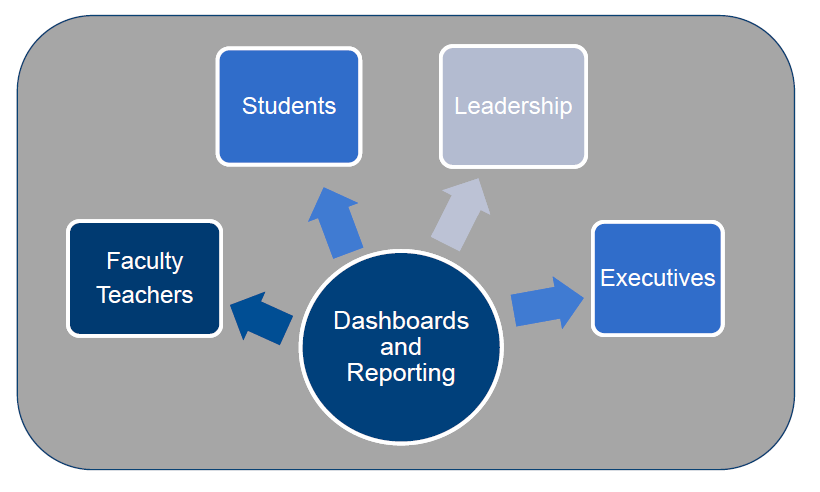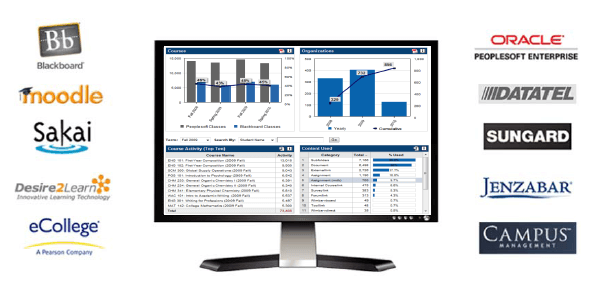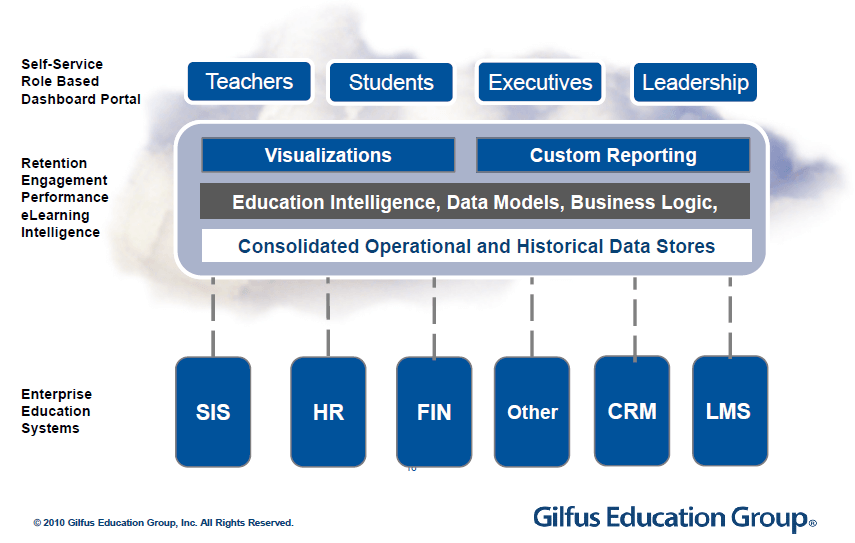Get the most out of your Enterprise Resource Planning, Student Information System and Learning Management system with Gilfus Education Group expert Analytics team members and explore our exclusive capabilities. the Gilfus Education Group provides consultative services that can leverage out-of-the-box technology to get the most out of your education systems. For Blackboard Analytics, Moodle Analytics, eCollege Analytics, Desire2Learn Analytics, and more.
Many companies talk about moving data to information. At the Gilfus Education Group we believe that a new day is dawning: a shift from the “Information Age” to the “Age of Intelligence,” where individual stakeholders and constituents not only get the information they need; they obtain it in an intelligent way. In this regard, the Gilfus Education Group implements intelligent planning, management, and measurement methodologies, empowering individual decision makers and facilitating the growth of a high performance organization.
Academic Analytics is the term for business intelligence used in an academic setting. There is an increasing distinction made between academic analytics and traditional BI because of the unique type of information that university administrators require for decision making. – Wikipedia
Why Academic Analytics
By leveraging technology, skills, and process improvements to bring data and analysis to bear on both strategic and operational decision-making, an academic analytics approach can empower decision-makers throughout the organization, make clear areas where resource allocations are at odds with priorities, and provide mechanisms to compare performance against professional standards or peer benchmarks.
In addition to alignment with strategic priorities, a successful academic analytics implementation can facilitate the integration of relevant and strategic information. Academic analytics can be seen as a key enabler for moving the an institution forward, as it directly impacts the decision making process at the highest levels of the University.
Academic Analytic Tools and Systems
To obtain transparency and critical insights Academic analytics relies on the extraction of data from one or more systems, typically a course management system/learning management system and a student information system as these two system provide the most critical insight into organizational, faculty and student performance. Some of the systems in today’s marketplace for Higher Education include Oracle, Datatel, Sungard, Jenzabar, Campus Management, Blackboard, Moodle, Sakai, Desire2Learn and eCollege. The central connection of data from these systems into a single logical entity provides the most granular insight possible. This data may be assembled live or stored into a data warehouse for ongoing use.
By creating a centralized source strong correlations can be made from individual user demographics, acceptance and enrollment, academic performance, and financial data and tied to real time activities, participation and content interactions
Once appropriate connectors are deployed into each system centralized data models can create an efficient means for assembling and constructing meaningful correlations that can be utilized as a baseline for executive and stakeholder insights. Role based dashboards and visualizations can then provide individuals with the intelligence they require to make strategic and effective decisions.
Challenges with Academic Analytics
- Deploying Academic Analytics is highly technical and requires participation from central IT organizations, putting more pressure on critical institutional resources.
- Most academic institutions do not have the capabilities within their IT organizations to support the ongoing needs for critical academic analytics. A true initiative requires ongoing analysis and collaboration between technical staff and institutional researchers.
- It is only the top tier of institutions that have dedicated institutional research shops solely focused on institutional effective and overall transparency. Even then most advanced Institutional Research organizations focus on historical performance and not real time performance.
- Most of today’s vendors only provide tools that speak to the technical need of obtaining the data and turning into information. Leaving most of the assemblance of the data and visualizations up to institutional staff. This once again leaves academic institutions aspiring to achieve insight but spending most of their every day activities in configuration and manipulation.
- The design and deployment of a highly capable academic Analytics Architecture is incredibly costly and demands expertise in a variety of systems with individuals focused on connectors to the main enterprise systems, the data stores and data models, visualizations, custom reporting and access control.
Academic Analytics Architecture
By deploying a centralized reference architecture in the cloud and consolidating expertise around the various systems, data models and visualizations the Gilfus Education Group aspires to provide academic analytics capabilities to a diverse set of academic institutions.
Academic Analytics and Digital Dashboards
Factors such as student recruitment and admission, teaching load, graduation rates, staff turnover, generated funds, and proposal-to-award ratios all affect a university’s performance. However, few higher education institutions are able to capture and report their many data points on all levels. A digital dashboard is a management tool for setting and measuring expectations at every organizational level, with easy-to-understand charts and reports of the status of progress throughout the year .
.
Such tools help users:
- Set performance goals and track performance indicators
- Spot trends easily
- Establish measures and criteria for monitoring progress
- Identify, track, trend, and correct problems
- Design and print charts and reports
- Evaluate and understand the organization’s health
- Identify operational efficiencies
- Meet regulatory requirements
How do you deliver dashboards that end users will adopt and use? Like many academic institutions your institution already has a load of data around campus. It simply needs a way to make it valuable to various constituents. A flexible development tool and design principles are required to put the icing on the cake. Choosing an effective dashboard tool enablesthe creation of education dashboards quickly by pulling academic analytics data from any system, including the data warehouse. Consulting with dashboard and design experts can make a huge difference in your implementation.
Higher Ed Analytics and Dashboards in Action
Here are a few recommendations:
- Embed education dashboards as a link within the institutional portal so users have one click access to the information
- The best screen size for the dashboard window is 1024 x 768
- Place the most important elements for viewing in the upper left hand corner and the least important in the lower right corner to mimic the way the eye scans a page.
- Avoid decorative education dashboard elements, like dials, gauges, and images and cluttering the screen with images and color.
- Design your executive education dashboard pages to mimic popular Web layouts.
- Create a summary screen of the most important information.
- Place elements on the screen so users don’t have to scroll.
- Add a “design tip” logo that users can click to get techniques about using the displayed elements and offer an online help center that provides a directory of topics for using the dashboards.
- Avoid pie charts, 3-D elements, and gradient shading.
- Accommodate color blindness.
- Accent key variables with subtle hues or patterns.
Assembling Academic Analytics
Developing a deploying an academic analytics initiative requires expertise across a number of critical areas.
- Define the systems that maintain the most critical data for reporting
- Develop capabilities to capture data from the various systems required
- Implement a centralized data store to cleanse data and develop data models and business logic
- Determine end user stake holders and applicable information for each stakeholder and define roles
- Create meaningful executive dashboards and visualizations for effective decision making.
- Maintain and support the series of systems and processes for ongoing evaluation.
Resources for Academic Analytics
7 Things You Should Know About Analytics”, EDUCAUSE 7 Things You Should Know series. April 2010.
Arnold, Kimberly E. “Signals: Applying Academic Analytics”, EDUCAUSE Quarterly, Volume 33, Number 1, 2010.
Campbell, John P. “Academic Analytics: A New Tool for a New Era” ELI Web Seminar, October 8, 2007. Audio and slides from the presentation.The session will be based on an article [PDF 601 KB] published in the July/August 2007 EDUCAUSE Review by John Campbell, Peter DeBlois, and Diana Oblinger.
Dawson, Shane, Liz Heathcote, and Gary Poole. “ Harnessing ICT potential: The adoption and analysis of ICT systems for enhancing the student learning experience” International Journal of Educational Management Volume 24, Number 2, 2010, pages 116-128.
Goldstein, Philip J. with Richard N. Katz, “Academic Analytics: The Uses of Management Information and Technology in Higher Education”, ECAR Research Study Volume 8, 2005. The following chapters specifically discuss using learning analytics to increase student retention and monitor student academic success.
- Chapter 7, Advanced Applications of Academic Analytics (Page 76, Student Services)
- Chapter 9, Academic Analytics in the Future of Higher Education
Kunnen, Eric J. and John Fritz, “Using Analytics to Intervene with Underperforming College Students”. EDUCAUSE Learning Initiative, Annual Conference, January 20, 2010. This is a video recording of a presentation.
Norris, Donald, Linda Baer, Joan Leonard, Louis Pugliese, and Paul Lefrere “Action Analytics: Measuring and Improving Performance That Matters in Higher Education”, EDUCAUSE Review, Volume 43, Number 1, January/February 2008.
Norris, Donald, Linda Baer, Joan Leonard, Louis Pugliese, and Paul Lefrere “Framing Action Analytics and Putting Them to Work”, EDUCAUSE Review, Volume 43, Number 1, January/February 2008.
Oblinger, Diana G. and John P. Campbell, “Academic Analytics” EDUCAUSE White Paper, October 2007.


